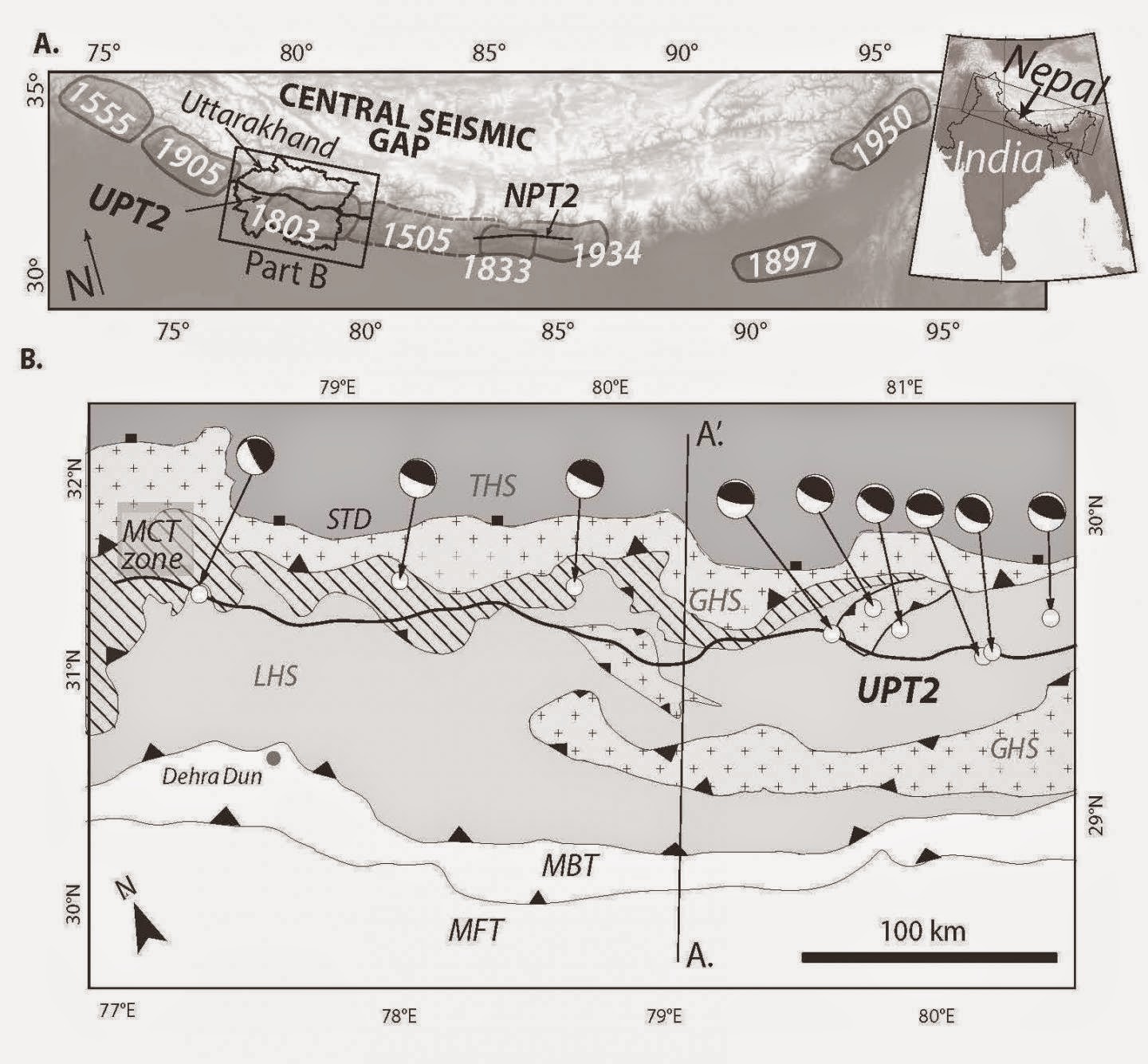
In their article for Lithosphere on 12 March, authors Kristin Morell and colleagues write, “The ∼700-km-long ‘central seismic gap’ is the most prominent segment of the Himalayan front not to have ruptured in a major earthquake during the last 200-500 years. This prolonged seismic quiescence has led to the proposition that this region, with a population of more 10 million, is overdue for a great earthquake. Despite the region’s recognized seismic risk, the geometry of faults likely to host large earthquakes remains poorly understood.”
A little more than a month on, the area experience a magnitude 7.8 earthquake, centered in Nepal (25 Apr. 2015).
In their study, Morell and colleagues use a series of complementary geomorphic and erosion rate data to define the ramp-flat geometry of the active detachment fault that is likely to host a large earthquake within the hinterland of the northwest Himalaya. Their analysis indicates that this detachment is sufficiently large to host another great earthquake in the western half of the central Himalayan seismic gap.
Specifically, their data sets point to a distinctive physiographic transition at the base of the high Himalaya in the state of Uttarakhand, India, characterized by abrupt strike-normal increases in channel steepness and a tenfold increase in erosion rates.
When combined with previously published geophysical imaging and seismicity data sets, Morell and colleagues interpret the observed spatial distribution of erosion rates and channel steepness to reflect the landscape response to spatially variable rock uplift due to a structurally coherent ramp-flat system of the Main Himalayan Thrust. They write, “Although it remains unresolved whether the kinematics of the Main Himalayan Thrust ramp involve an emergent fault or duplex, the landscape and erosion rate patterns suggest that the décollement beneath the state of Uttarakhand provides a sufficiently large and coherent fault segment capable of hosting a great earthquake.”
In conclusion, they note, “While this hypothesis remains speculative, it is supported by independent records of historical seismicity.”
*Photo Caption:
Figure 1. (A) Date and rupture patches for large historical Himalayan earthquakes (Rajendran and Rajendran, 2005; Kumar et al., 2006) with reference to the Uttarakhand region of the central seismic gap, and the physiographic transition 2 of Uttarakhand (UPT2 ) and Nepal (NPT2 ) (Wobus et al., 2006a). (B) Simplified geologic map for area shown in A (Célérier et al., 2009a; Webb et al., 2011). Focal mechanisms of all earthquakes within the recording period (Mw 5-7) are shown with location as white circle. Earthquake locations are based on Ni and Baranzangi (1984) and the National Earthquake Information Center (NEIC) catalog (earthquake.usgs.gov). Focal mechanisms are based on Ni and Baranzangi (1984) or the Global Centroid-Moment-Tensor (CMT) catalog (globalcmt.org). STD–South Tibetan Detachment; THS–Tethyan Himalayan Sequence; MCT–Main Central Thrust; GHS–Greater Himalayan Sequence; LHS–Lesser Himalayan Sequence; MBT–Main Boundary Thrust; MFT–Main Frontal Thrust.
Reference:
Geomorphology reveals active decollement geometry in the central Himalayan seismic gap
K.D. Morell et al., University of Melbourne, Melbourne, Victoria, Australia. Published online ahead of print on 12 Mar. 2015; DOI: 10.1130/L407.1.
Note : The above story is based on materials provided by Geological Society of America.










